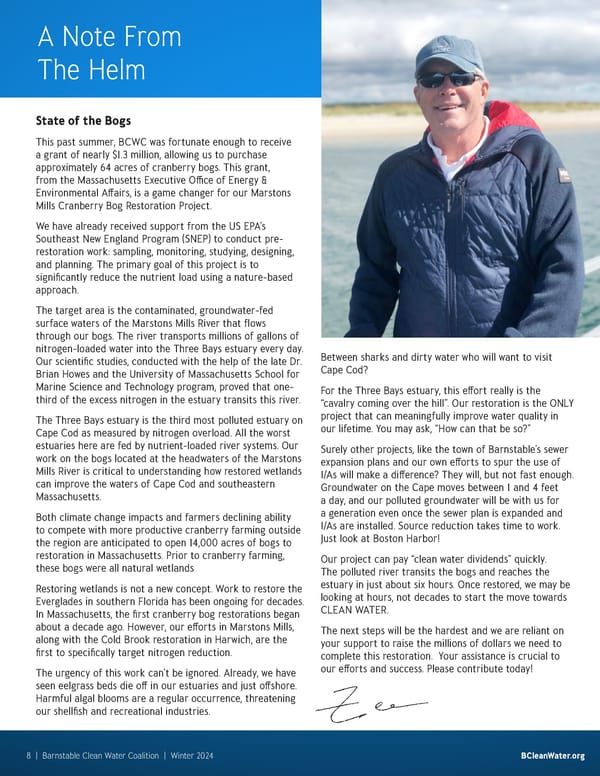A Note From The Helm State of the Bogs This past summer, BCWC was fortunate enough to receive a grant of nearly $1.3 million, allowing us to purchase approximately 64 acres of cranberry bogs. This grant, from the Massachusetts Executive O昀케ce of Energy & Environmental A昀昀airs, is a game changer for our Marstons Mills Cranberry Bog Restoration Project. We have already received support from the US EPA’s Southeast New England Program (SNEP) to conduct pre- restoration work: sampling, monitoring, studying, designing, and planning. The primary goal of this project is to signi昀椀cantly reduce the nutrient load using a nature-based approach. The target area is the contaminated, groundwater-fed surface waters of the Marstons Mills River that 昀氀ows through our bogs. The river transports millions of gallons of nitrogen-loaded water into the Three Bays estuary every day. Between sharks and dirty water who will want to visit Our scienti昀椀c studies, conducted with the help of the late Dr. Cape Cod? Brian Howes and the University of Massachusetts School for Marine Science and Technology program, proved that one- For the Three Bays estuary, this e昀昀ort really is the third of the excess nitrogen in the estuary transits this river. “cavalry coming over the hill”. Our restoration is the ONLY The Three Bays estuary is the third most polluted estuary on project that can meaningfully improve water quality in Cape Cod as measured by nitrogen overload. All the worst our lifetime. You may ask, “How can that be so?” estuaries here are fed by nutrient-loaded river systems. Our Surely other projects, like the town of Barnstable’s sewer work on the bogs located at the headwaters of the Marstons expansion plans and our own e昀昀orts to spur the use of Mills River is critical to understanding how restored wetlands I/As will make a di昀昀erence? They will, but not fast enough. can improve the waters of Cape Cod and southeastern Groundwater on the Cape moves between 1 and 4 feet Massachusetts. a day, and our polluted groundwater will be with us for Both climate change impacts and farmers declining ability a generation even once the sewer plan is expanded and to compete with more productive cranberry farming outside I/As are installed. Source reduction takes time to work. the region are anticipated to open 14,000 acres of bogs to Just look at Boston Harbor! restoration in Massachusetts. Prior to cranberry farming, Our project can pay “clean water dividends” quickly. these bogs were all natural wetlands The polluted river transits the bogs and reaches the Restoring wetlands is not a new concept. Work to restore the estuary in just about six hours. Once restored, we may be Everglades in southern Florida has been ongoing for decades. looking at hours, not decades to start the move towards In Massachusetts, the 昀椀rst cranberry bog restorations began CLEAN WATER. about a decade ago. However, our e昀昀orts in Marstons Mills, The next steps will be the hardest and we are reliant on along with the Cold Brook restoration in Harwich, are the your support to raise the millions of dollars we need to 昀椀rst to speci昀椀cally target nitrogen reduction. complete this restoration. Your assistance is crucial to The urgency of this work can’t be ignored. Already, we have our e昀昀orts and success. Please contribute today! seen eelgrass beds die o昀昀 in our estuaries and just o昀昀shore. Harmful algal blooms are a regular occurrence, threatening our shell昀椀sh and recreational industries. 8 | Barnstable Clean Water Coalition | Winter 2024 BCleanWater.org
 BCWC Fall23Winter24 Newsletter Page 7 Page 9
BCWC Fall23Winter24 Newsletter Page 7 Page 9